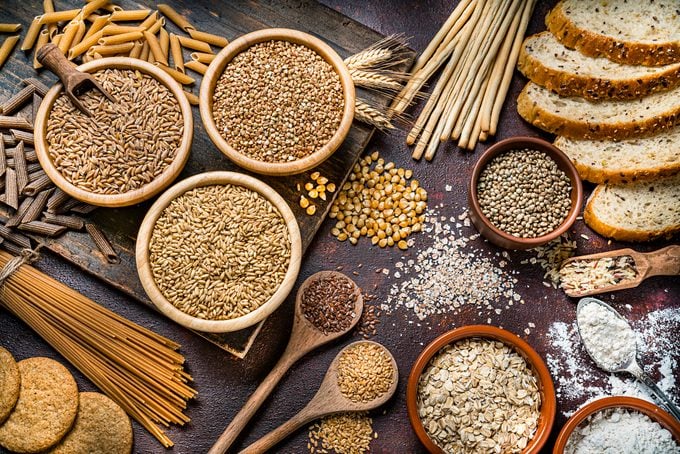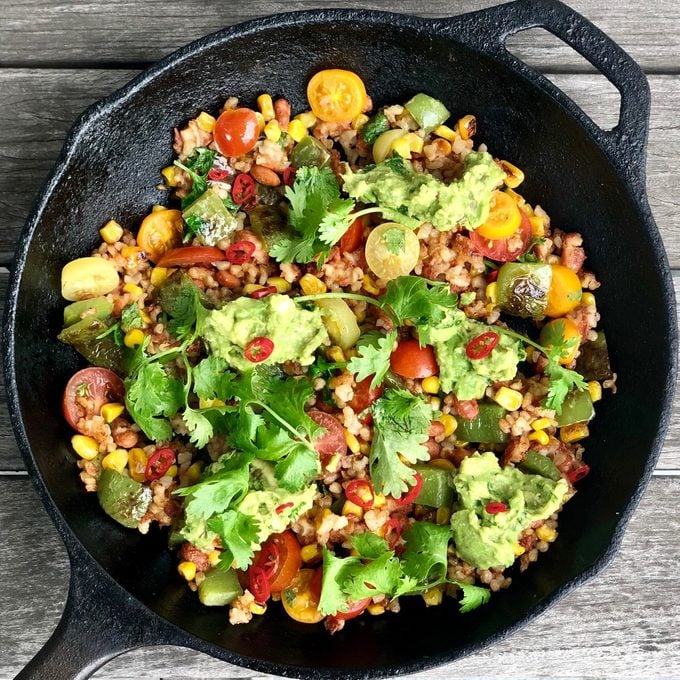9 Gluten-Free Grains You Should Know About
Updated: Aug. 04, 2021
Looking for a gluten-free grain? Here's a list to choose from, including gluten-free whole grains.
Our editors and experts handpick every product we feature. We may earn a commission from your purchases.
Why people want gluten-free grain options
Gluten-free grains are important pantry staples for many people.
That group includes people diagnosed with celiac disease (an intestine-damaging autoimmune disorder), gluten intolerance, or a wheat allergy.
For everyone else, they can also offer some health and cuisine benefits (but not in every case).
Here’s what to know about gluten-free grains. Plus, a gluten-free grains list for easy shopping.
What are gluten-free grains?
Think of gluten like food glue. Or, in more palatable terms, consider it a sticky protein that helps hold food together, keeping it shapely. That’s a good thing in the culinary sense.
Gluten is in wheat, barley, rye, and triticale—and, of course, all of the many forms of wheat, such as bulgur, durum, einkorn, emmer, farina, farro, graham, Kamut, semolina, spelt, and wheatberries.
For those who need to avoid gluten for health reasons, eating tiny amounts of these grains—even if they are far down on an ingredient list of soups, sauces, salad dressings, and other products, like supplements or even makeup—can cause gastrointestinal distress or an immune response that can damage the body.
Finding gluten-free grains
If you need or simply want to choose gluten-free grains and grain-based foods, it’s far easier to do that today than ever before, thanks to its burgeoning popularity and continuing cuisine innovation.
In fact, from 2021 to 2027, the gluten-free food market globally is forecasted to grow at a compound annual growth rate of nine percent, according to Market Watch.
One big caveat: You need to know what to look for in bulk bins or the grain aisle.
Some gluten-free picks you’ll want to embrace are rice, amaranth, buckwheat, corn, millet, sorghum, teff, quinoa, and fonio.
While some of these are classified as pseudo-cereals—basically grain-free seeds—they’re highly nutritious and can be eaten just like grains.

Are there gluten-free whole-grains?
You’re in luck. All grains are born as whole-grains, including gluten-free grains.
So, when avoiding gluten, aim to enjoy mainly foods featuring whole-grain versions of rice, corn, sorghum, and more—and their whole-grain flours.
This offers the best health advantage since you’ll be getting all parts of the grain, including the fiber-packed bran and nutrient-rich germ.
In practical terms, when going for grains, aim for whole-grains like brown rice, instead of processed, refined grains like white rice, most of the time to obtain all of its edible plant-based benefits.
Gluten-free grains and pseudo-cereals (seeds)
Use the below list as a mini-summary of gluten-free whole-grains and pseudo-cereals. For cooking tips, check out this basic guide on how to cook whole-grains.
Brown rice
A darling of gluten-free grains, brown rice is notable for its antioxidants, B vitamins, and magnesium.
It’s available in short (stickier) and long-grain (fluffier) varieties. Brown rice takes longer to cook than refined white rice, but offers a chewier texture and nuttier taste.
Find whole-grain rice in other cool colors, too, including red, purple, and black, which offer a boost of bioactive compounds.
For bonus nutrition and culinary intrigue, use these whole-grain rice varieties as a better-for-you swap instead of white rice.
Whole-grain amaranth
This tiny, misunderstood “whole-grain” is chockfull of nutritional features. A cup of cooked amaranth offers a healthful kick of protein (9 grams), fiber (5 grams), and minerals, including iron, potassium, and calcium.
While amaranth is classified as a pseudo-cereal, people enjoy it like a grain, such as an oatmeal- or porridge-style hot cereal.
Tip: Amaranth becomes nuttier by pan-toasting it at the beginning of recipe prep.
Whole-grain buckwheat
Buckwheat is another pseudo-cereal. It can punch up the protein, fiber, magnesium, or potassium in your eating repertoire. And in a totally nutty, hearty, and rather earthy way.
You’ll adore it ground into flour as the star of buckwheat crepes or pancakes. It’s sometimes combined with all-purpose (wheat) flour to lighten up texture and tone; so be aware of this when dining out. Buckwheat can also be enjoyed in soba noodles and as groats (kasha).
Whole-grain corn
Instead of nibbling on corn-on-the-cob as a veggie, corn could transform into comforting cornmeal (also called polenta) or hominy (an alkali-treated dried corn) dishes.
Yellow cornmeal is a standout nutritionally for the eye-protective lutein and zeaxanthin it offers. When cooked, polenta can be enjoyed as hot cereal or even crispy fries (yum).
And, of course, corn can be ground and found in corn tortillas and chips.
Whole-grain millet
Birds can peck on millet. But it’s also a gluten-free seed that you’ll want to toss into your own diet, especially due to its notable amount of protein, magnesium, phosphorus, and heart-protective antioxidants.
Plus, according to a research review published in Frontiers in Nutrition, regularly eating millet may help reduce blood glucose and risk for developing diabetes.
Mild tasting, millet is best when seasoned and spiced up. It’s also tasty when you toast it before using it in recipes, giving it extra nuttiness.
The seeds add delightful texture to breads and quick-breads. Millet flour is a great ingredient for homemade bread, too.
Whole-grain sorghum
Nutty, chewy sorghum is an ancient grain with lots to boast about. It’s got plenty of protein, fiber, and potassium, plus plant sterols with potential cholesterol-lowering abilities.
As a bonus, sorghum is good for the planet, especially since it is mainly rain fed instead of relying on irrigation.
Serve it just like rice, quinoa, or Israeli couscous. And as a fun food, pop whole-grain sorghum just like traditional stovetop popcorn.
Whole-grain teff
Teff is an itty, bitty-sized seed that’s big on minerals, including iron, calcium, magnesium, and zinc.
There are numerous varieties and shades, but you’ll likely find a reddish-brown variety with bold flavor and a hint of earthy sweetness.
Serve whole teff as a hot breakfast cereal; mix it with millet or quinoa in a pilaf; or try it as an intriguing flour choice for chewy cookies.
Quinoa
Quinoa is a seed with a double whammy of plant protein and dietary fiber, making it quite satiating. If you’re looking for a good source of iron or anti-inflammatory antioxidants, it’s got those, too.
Choose various colors, including white and heartier tasting red and black.
Enjoy it like rice or as the main ingredient of stuffings, salads, and desserts.
Hint: Unless purchasing pre-rinsed quinoa, rinse it before cooking to reduce bitterness from naturally-occurring plant chemicals called saponins.
For “outside the box” quinoa dishes, check out these creative quinoa recipes.
Fonio
Fonio is an ancient, nutty, earthy grain from West Africa, but it’s only recently been popping up in the marketplace in America. Iron is its standout nutrient. It looks and cooks like couscous … in five minutes flat.
Serve it like a couscous-style side or salad, or in grain bowls, veggie burgers, and beyond.
By the way, choose any gluten-free whole-grains and pseudo-cereals ground into flours and enjoy within grain-based foods, such as soba noodles made exclusively with 100 percent whole-grain buckwheat flour or whole-grain gluten-free bread featuring brown rice as its first ingredient.
What about oats?
The oats in that comforting bowl of oatmeal are unique since they’re technically gluten-free.
However, since they can be grown or processed near wheat, barley, or rye, they can come into “cross-contact” with gluten.
That’s why you may need to avoid oats on a gluten-free eating plan unless you can be certain the oats are free of gluten.
If you have access to the food label, medical experts with the Celiac Disease Foundation advise only choosing oats labeled gluten-free.
The good news is that all lovable forms of oats are whole-grains. This includes oat groats, steel-cut (or Irish), old-fashioned rolled oats, quick-cooking and, surprisingly, instant oats.
A fiber in oats called beta-glucan may help manage blood glucose and blood cholesterol levels, per Europe PMC.
Just try to skip instant oats if you prefer less processed grains or a chewier texture.
Do serve them up in sweet and savory (hello ris-oat-o, which is a savory version of oatmeal treated more like the rice dish risotto), and hot and cool ways.
Finding gluten-free whole-grain products
Beyond just the grains, there’s a blossoming array of gluten-free grain products in the supermarket that exclusively contain whole-grains, pseudo-cereals, or provide significant amounts of them.
Do a little ingredient list reading to make sure you’re choosing them. This mini-highlights list can help you out:
- Sliced Bread: Little Northern Bakehouse Organic Ancient Grain Gluten-Free Bread—contains organic brown rice flour as the key ingredient of a gluten-free flour blend
- Bagels: Udi’s Gluten-Free Whole Grain Bagels—features brown rice flour
- Flour Tortillas: La Tortilla Factory Gluten-Free, Wheat Free, Ivory Teff Wraps—in addition to tapioca flour, it contains whole-grain ivory teff flour and whole-grain millet flour
- Baking Mix: ‘Okina Classic Base Muffin + Bread Baking Mix—made with freshly-milled, gluten-free flour blend based on organic oats
- Pasta Noodles: Jovial 100% Organic Gluten-Free Brown Rice Pastas—feature organic brown rice flour and water — that’s it
- Soba Noodles: Eden Foods Organic Buckwheat Soba—only has one ingredient: 100 percent whole-grain buckwheat flour
Tip: Also, be on the lookout for a growing array of grain-free, gluten-free flours and products featuring nuts, pulses, coconut, and more.
Jackfruit flour and okara flour are a couple of the newest.
And the gluten-free pasta choices seem endless, with selections like yellow pea penne, cauliflower linguine, and almond flour fettuccine.
Should you avoid gluten-containing grains?
Avoiding gluten is vital for some people, but not everyone needs to or should jump onboard a gluten-free lifestyle.
Like any diet that eliminates specific foods, it can have undesirable consequences if followed improperly.
For instance, a gluten-free diet of mostly processed foods could lead to insufficient fiber intake and fewer health-promoting nutrients.
It may lead to weight gain if you mistakenly believe going gluten-free is a no-brainer strategy for shedding excess pounds.
After all, chowing down a bagful of gluten-free cookies will not shrink your belly.
Plus, swapping gluten-free grains and gluten-free grain flour into your cooking and baking may negatively impact cuisine texture and, in some cases, taste.
So, if you don’t need to avoid gluten, go ahead and enjoy the glorious array of grains available, like barley, rye, einkorn, emmer, Kamut, spelt, bulgur, and durum wheat—all of which contain gluten. And savor gluten-free grains as you wish, too.
Gluten-free grain recipes
Whether you’re choosing to go gluten-free out of necessity—or you simply want to reduce gluten due to personal desire—there’s no reason to have lackluster meals.
Indulge in my inspired, plant-forward gluten-free recipes that are packed with flavor and wholesomeness.

IMAGE COURTESY OF JACKIE NEWGENT, RDN, CDN
- Mexican Caramelized Rice and Veggie Skillet
- Savory Kale and Crimini Oatmeal with Fried Egg
- Seasonal Farmers Market Fried Quinoa
Like mini-cookbooks, try these popular recipes featuring gluten-free grains and grain foods.



















